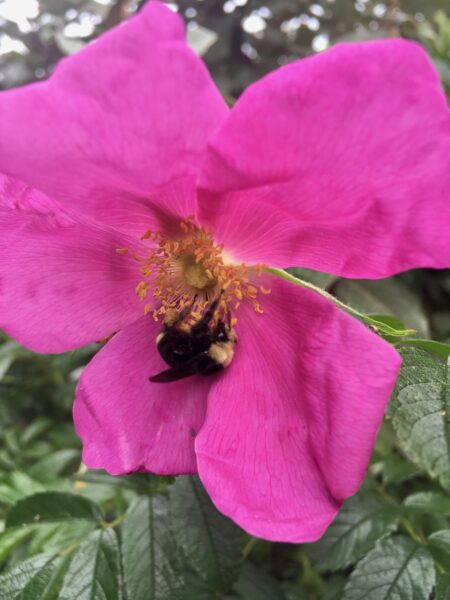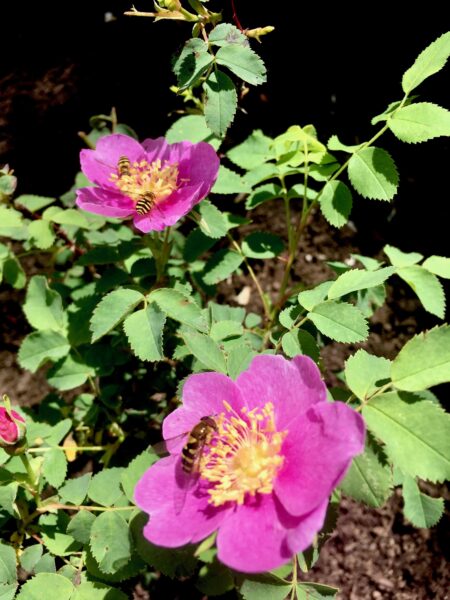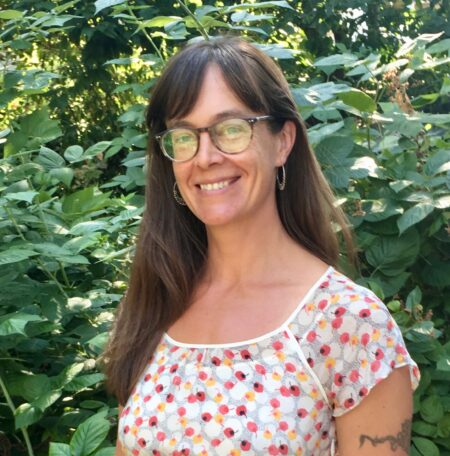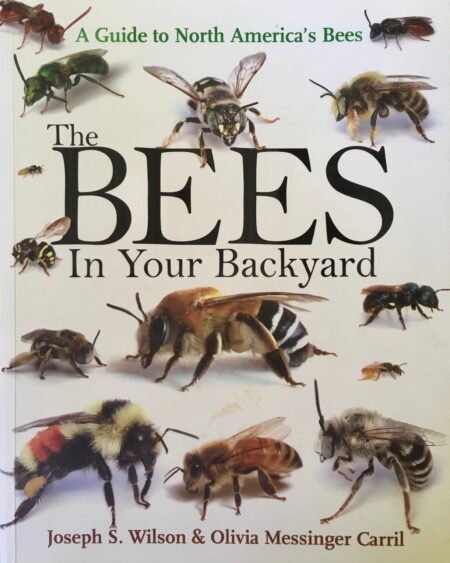Stop and See the Bees – #2 in the not dumbed-down pollinator gardening series
May 30, 2020
The hidden benefit of gardening for pollinators is the sense of well-being that comes from watching the myriad flying visitors, like real living fairies, dart and dash and sup and rest amidst the blooms.
In the first of this series on pollinator gardening, I gave you a specific tip to attract more bees to your garden. If you missed it, you can read it here. In this essay, my goal is to inspire you to enjoy your garden in a new way.
Walking through my garden meadow, bare feet on one sun-warmed stone at a time, I slow my rush to the office and come to a stop as a honeybee catches my eye. My breathing slows, my gaze engages with the small and wondrous. The world of lists and tasks, of bills and emails, falls away and I come to the present. Here and now, blooms and bees animate the garden and open my mind to awe.
I hope you’re aware of the perils that pollinators face. I don’t care to enumerate the statistics of doom here. Fear based motivation is not compelling for me. But what does move me is beauty. And there are layers and depths of beauty to behold in a garden planned and tended with pollinator habitat in mind.
Lately, I’ve taken to “bee-ing” on a daily basis. Bee-ing is to bee watching as birding is to bird watching. Looking closely at bees is more accessible than birding because you can get closer before they fly on. And then, they only fly to the next nearest flower. Whereas birds tend to have a higher and broader range and require quite a bit of patience and a decent pair of binoculars to view in detail.
As Ralph Waldo Emerson put it, “The world is emblematic. Parts of speech are metaphor, because the whole of nature is a metaphor of the human mind.” Practicing bee-ing becomes a discipline for being.
Bee-ing as a hobby is perfect to pick up now that we’re staying home more. All you have to do is put your phone down, go into your yard and start seeing the winged wonders doing their thing. If you’ve planted some shrubs and flowers, you’ll find more to look at than if you have only lawn, but even a lawn can host native miner bees on its daisies and sweat bees on its dandelions.
I’m only suggesting here that you start by seeing bees. A few minutes of attending to the buzzy happenings will work its magic on your mood.

After that, if you want more, you could learn how to tell a bee from a fly. (Hint: flies have stubby antennae, while bees antennae are long and slender. Flies eyes are large and forward facing rather than bees which are on the sides of their heads. And flies have two instead of bee’s four wings.) But just looking and wondering without knowing names or science has a deeply therapeutic effect on your anxious mind. Right out your door life continues, humming and nectaring, mating and predating. Look! It’s nature doing her thing.
With closer study, you’ll come to recognize honeybees. If there’s a hive within two miles of your garden, honeybees will definitely find your flowers and communicate to their sisters via waggle dance the exact location of the tastiest of your offerings.
You’re also likely to recognize bumblebees, those big fuzzy cuties that bobble from the end of each flower in turn. Because they’re so large, it’s relatively easy to start to notice the varying coloration and, thus, the different species, that visit your garden. Do you see a yellow face? Or an orange rump? Those are the two I see most on my raspberries and wild roses.
Did you know there are also tiny black bees? And iridescent green bees? You might even see red bees! Those will likely be a species of cuckoo bee that lay their eggs in the nest of other bees, robbing the pollen for their own young.
The world of bees is endlessly fascinating. Whether you totally nerd out on the specifics or just have fun looking, bee-ing is a relaxing pastime that connects you to nature and enhances your gardening enjoyment.
Planting more natives is sure way to expand the diversity of bees that visit your garden. Whereas honeybees will feast on a wide range of garden flowers, some native bees will only feed from their specific native host plant. Who knows, your garden could be the thing that makes the difference for a compromised species! How good would that feel?
Once you start seeing bees, you’ll inevitably notice other insects in your garden. Like hover flies which are bee mimics and important pollinators, too. And, check this out, hover fly larvae eat aphids! Spying them in your garden puts your mind at ease about the pests congregating on your rose buds. Nature takes care of the balance when you garden for habitat.

Try bee-ing and tell me how you feel. Does it bring you peace of mind? Does it motivate you to make more pollinator habitat? Do you want to learn the names of your garden inhabitants? How can I help you bee? Comment below.

As with all hobbies, dive in and you’ll find a slew of other interested folks that share with passion. Some resources I love include:
Book:
The Bees In Your Backyard by Joseph S. Wilson and Olivia Messinger Carril

On Instagram:
@the_bees_in_your_backyard (great videos and bite-sized educational info)
@guyjasna (love her artistic studies of bees and pollen)
@augustjackson (our local expert who’s published a free guide to bees of the Willamette Valley)
Podcast:
PolliNation (Andony Melathopoulos, of OSU hosts excellent interviews.)
Identification and citizen science:
iNaturalist app (If you can get a good photo, this is the best app for ID. Great for anything you see in nature, not just pollinators.)
And if you want to take this hobby to it’s peak, check out the Oregon Bee Project. You could become a master melittologist!

Leslie – thank you for sharing your enthusiasm! You may not remember the “snow bell” tree on the hopefully doomed front grass at our house, or that I was somewhat doubtful about it in its winter seed dropping state, but now— wow! It is a mass of blossom and it seems most of them have a visiting bee. There are even bees on the fallen blossoms! It’s an orchestra in the mornings!
Cora – How wonderful! Let’s keep it! I’m really looking forward to working with you soon.